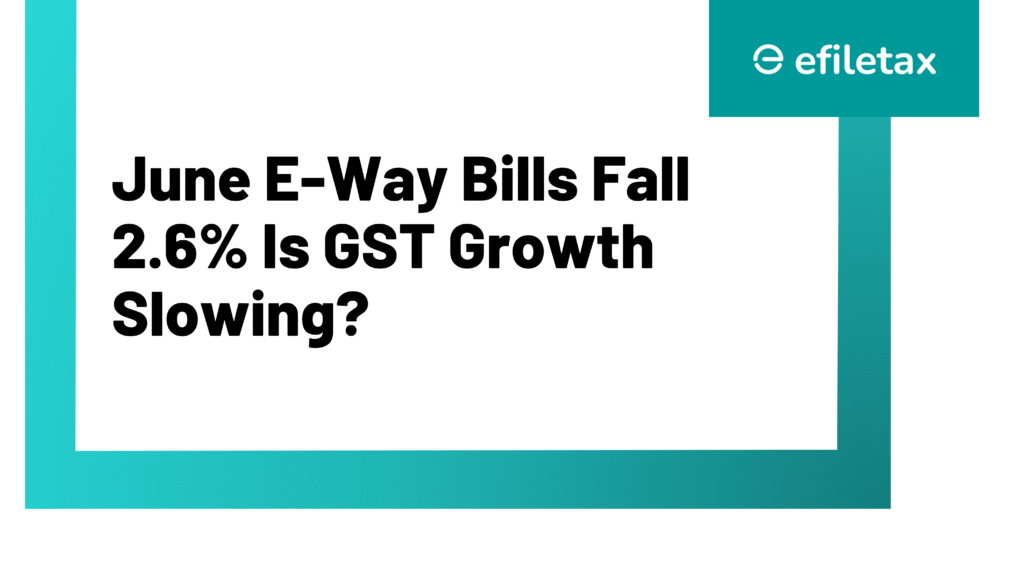
June e-way bill data: A signal for GST moderation?
June 2025 saw a 2.6% dip in e-way bill generation, raising questions about slowing economic momentum and its impact on GST collections. With e-way bills acting as a proxy for goods movement in India, this trend is worth watching—especially ahead of the next GST revenue update.
What are e-way bills and why do they matter?
Under Rule 138 of the CGST Rules, an e-way bill is mandatory for the movement of goods worth over ₹50,000 in a single invoice. It applies to both inter-state and intra-state supplies and is auto-linked with GST returns (GSTR-1).
Why e-way bills matter:
- Real-time goods tracking: Helps curb tax evasion
- Revenue forecasting: Acts as a lead indicator for GST revenue
- Policy pulse: Reflects trade volume shifts, especially in manufacturing and logistics sectors
Key June 2025 data points
| Particulars | May 2025 | June 2025 | Change |
|---|---|---|---|
| Total e-way bills generated | 9.20 crore approx. | 8.96 crore approx. | ↓ 2.6% |
| Inter-state movement | ~3.37 crore | ~3.24 crore | ↓ 3.8% |
| Intra-state movement | ~5.83 crore | ~5.72 crore | ↓ 1.9% |
Source: NIC e-Way Bill Portal | https://ewaybill.nic.in/
What does this decline indicate?
- Trade slowdown: A dip in goods movement may point to temporary demand contraction, possibly from sectors like textiles, FMCG, or chemicals.
- GST revenue moderation: Although not always directly correlated, a fall in e-way bills may mean lower GST revenue collection for July 2025 (reflecting June activity).
- Pre-monsoon effect: June often sees supply-chain adjustments due to monsoons—especially in agrarian and construction sectors.
- Inventory cycle reset: Some businesses may have frontloaded purchases in May, reducing June movement.
Legal and compliance angle
E-way bills are closely monitored by the GST Network (GSTN) and CBIC for compliance. In recent months:
- AI-based analytics are flagging discrepancies between e-way bill data and GSTR-1/GSTR-3B returns
- Non-generation or mismatch can lead to penalties under Section 122 of CGST Act, 2017
- Rule 138E still restricts e-way bill generation for non-filers of GSTR-3B
Taxpayers must ensure reconciliation of e-way bills with their outward supply returns to avoid notices or ITC issues.
Expert Tip: Watch sector-specific signals
According to trade experts, micro trends matter more than the headline number. For instance:
- A dip in inter-state bills may suggest reduced logistics activity
- A rise in intra-state bills during monsoon could reflect localised consumption revival
For GST consultants and SMEs, tracking e-way bill dashboards monthly can provide advance cues for client advisory, compliance planning, or inventory decisions.
Practical action points for businesses
- Reconcile e-way bills with GSTR-1 monthly
- Check for any blocked e-way bill generation (Rule 138E)
- Ensure transporters are GST-compliant
- Keep an eye on NIC e-way bill alerts and system downtime notices
Read: Efiletax explainer on Rule 138E and blocking of e-way bills
FAQ
Q1: Will lower e-way bills definitely mean lower GST revenue?
Not always. E-way bills reflect goods movement, but service sector GST remains unaffected. However, consistent drops usually signal a revenue dip.
Q2: Can e-way bills be amended after generation?
Only limited fields like transporter ID can be updated. If invoice details are wrong, cancel and regenerate within 24 hours.
Q3: Is e-way bill required if invoice value is under ₹50,000?
Not mandatory, unless transporting specific goods like tobacco, pan masala, or notified items.
Final thoughts
The 2.6% fall in June e-way bill generation might be seasonal—or an early sign of GST moderation. Businesses should stay proactive with monthly reconciliation and monitor trade indicators closely. As always, Efiletax can help you file on time, avoid penalties, and stay compliant.
Summary
June 2025 e-way bills fell by 2.6% compared to May, possibly signalling a GST slowdown. With inter-state bills down nearly 4%, experts suggest monitoring monthly goods movement data for early compliance and advisory cues. Timely e-way bill reconciliation is key.